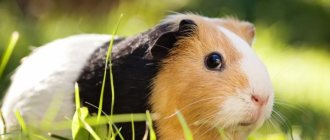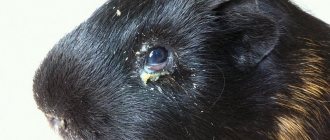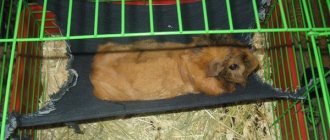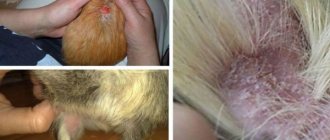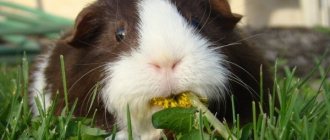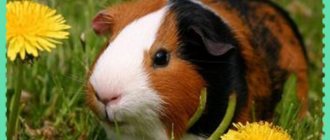The guinea pig is a typical representative of the rodent order. However, it differs in many ways from many of its counterparts. Pigs are smart, they know their owner, they can even be trained. In a word, this is an almost ideal pet. However, pigs have some specific anatomical features, and therefore require additional care and attention from the owners.
That is why it is important to find out all its physiological data before buying a guinea pig. Undoubtedly, such knowledge will help the owner to surround the pet with care and attention and provide decent living conditions.
Guinea pig teeth
The rodent has sharp and well-developed incisors, which grow throughout the life of the animal. Sometimes the incisors reach such sizes that they can cause discomfort to the animal and even injure the tongue or lips. The pig has no fangs, and the molars have characteristic folds and tubercles.
The lower jaw is equipped with only ten teeth:
- 2 false roots,
- 6 indigenous
- 2 incisors.
The lower jaw is characterized by high mobility, which is expressed in the ability to move in different directions (and not just forward and backward). On the upper jaw there are:
- 2 false roots;
- 6 indigenous;
- 2 incisors.
Moreover, the incisors are shorter than those on the lower jaw. The front teeth have very strong enamel, but on the back teeth it is soft and therefore wears off quickly.
Number of toes and nail care
The animal is distinguished by short legs, with the front legs being smaller than the hind legs. There are 4 toes on the hind paws and 3 on the front paws. To many owners, they resemble hooves.
Animal claws require special care. The fact is that they grow incredibly quickly and need periodic trimming. Long claws make it difficult for the animal to walk, and in some cases cause deformation of the feet. For the nail trimming process, you can use nail scissors or a scratching post, which can be easily found in a pet store. With weak pigmentation of the claws, in some cases the vessels of the circulatory system are visible. In this case, it is necessary to trim the claws, avoiding contact of the scissors with the blood vessels. With black or brown claws the task becomes more complicated. You need to cut it in such a way that the overgrown part of the claw is beveled inward. If blood is noticed after the procedure, the wound must be disinfected using standard methods.
Skeleton
The guinea pig skeleton consists of 258 bones:
- tail – 7 pcs.;
- ribs – 13 pairs;
- vertebrates – 34;
- scull;
- rib cage;
- hind legs - 72.
However, a large number of bones does not mean their strength. The fragile bones of the animal’s limbs are especially prone to damage and fractures. Every owner should remember this.
Nuances of the digestive system
It is worth remembering that animals have weak intestines. This is why animals chew their food thoroughly. The stomach consists of 1 chamber and fairly thin walls. Food usually enters the intestines within 5 hours. The type of animal’s intestines is “fillable”, that is, food moves through it as new food arrives. Therefore, long-term fasting is contraindicated for animals. Lack of food often becomes the cause of gastrointestinal problems and even death.
Interesting fact. The complete process of digesting one meal in an animal often takes up to 5–7 days. And the total length of the animal’s intestinal tract exceeds the body size by more than 2-3 times.
Basic rodent systems and their features
The hematopoietic and blood supply system is exactly the same as that of other rodents. The heart weighs about 2 grams. and beats at a frequency of 350 beats per minute.
The respiratory system is distinguished by excessive sensitivity to bacteria and infections of various kinds; animals often suffer from respiratory diseases.
The digestive system is well developed, the stomach reaches a volume of 30 cm, the intestines are extended and have a size 12 times the length of the body. It is for this reason that pigs take a very long time to digest food, about a week.
An interesting feature of the pig’s body structure is the fecal pocket located below, under the anus. The glands of the fecal pouch produce a specific thick secretion. This is another important point in caring for a guinea pig - the pocket needs to be cleaned periodically.
The owner should pay special attention to the health of the lymph nodes located near the ears on the neck. Unusual or too lethargic behavior, poor appetite - a reason to consult a veterinarian. Inflammation of the lymph nodes can lead to an abscess, which is very rare in pigs.
Taste buds
First, the animal tries to identify food by smell. If this cannot be done, then they taste it.
Thanks to the development of intelligence and memory, as well as good taste, they are quite able to distinguish edible from inedible.
Also, pigs often determine high-quality products from low-quality ones. Pigs have developed an individual taste and diet, as well as favorite dishes, which should be selected for each animal personally. But most people prefer succulent and sweet food options.
Peculiarities of vision, hearing and smell of a guinea pig
Cute fluffies have a remarkable ability to observe the entire space around them. This is achieved thanks to the lateral position of the eyes. However, this feature leads to certain problems: the frontal vision of pigs is weakened.
Since pigs are nearsighted, nature compensated by giving them a powerful sense of smell. This is the main landmark in the life of a rodent. The power of smell is hundreds, or even thousands of times stronger than that of humans. Thanks to such a powerful tool, males determine the possibility of females to mate; they are able to sense odors that humans are not even aware of.
The animal navigates the area using tactile hairs on its face. Even in pitch darkness, the animal is able to assess the size of the hole and the ability to penetrate it.
The guinea pig compares favorably with mice and rats in its sensitive hearing. The bulk of mammals have a standard ear structure, where the inner cochlea consists of 2.5 turns. But a guinea pig has 4 such turns. This allows the pig to perceive sound in the range of up to 3000 Hz, while a person hears only 1500 Hz.
Taste perception
If the mammal is not able to identify the offered food by color or smell, then it tastes a piece of the treat. Guinea pigs have a very good memory and a highly developed instinct, which helps them recognize edible and inedible, tasty and not tasty objects. When it comes to food, guinea pigs are individualists. What one may like may not always be to the taste of another. However, most prefer sweet and juicy foods and rarely eat salty or spicy foods.
General physiological data of a rodent
Let's now talk about the basic physiological parameters of rodents. A standard pig lives for 8 years, weighs about two kg, and grows up to 30 cm in length. Among these cute rodents there are also long-livers, some animals live up to 10 years. The body temperature of an adult pig is 39 °C. Sexual maturity occurs in females at 40 days, in males at 60. After a 70-day pregnancy, each female brings a litter of up to 5 cubs.
The anatomy of a guinea pig differs in other ways. For example, the excretory system of a guinea pig is well developed and the animal produces about 55–60 ml of urine per day.
Guinea pigs are gentle and sensitive animals, they are afraid of drafts and dampness. It is important to take this fact into account when creating decent living conditions for your pet.
If there are any signs of illness: decreased motor activity, prolonged silence, which is uncharacteristic of a healthy animal, you need to observe the animal. If the animal is trembling, the fur is disheveled, breathing is rapid, and possibly loose stools - you should immediately consult a veterinarian.
Ear structure
As mentioned above, thanks to improved hearing aids, pigs are more receptive to sounds. Unlike humans, who can distinguish 15,000 Hz, pigs pick up waves of twice the frequency. According to research, pigs can also recognize waves that are inaccessible to humans and a number of instruments. For example, they may hear a bang in another room.
The animals have nothing to do with the sea or pigs. According to one version, the animal received its name because of the special structure of its head. In addition to the special structure described earlier and resembling a pig on an enlarged scale, they lack a tail. If the pig is calm, then its voice resembles vibrations of water, and when frightened the animal starts to squeal. The squeal sometimes resembles a grunt, therefore, according to the second theory, pigs got their name because of this similarity.
Nutrition
The lifespan of rodents also directly depends on what guinea pigs eat. The basis of the daily diet is hay, and in the summer - grass. It should be in the cage constantly and regularly replaced with a new one.
In addition, it is worth diluting the diet with fresh vegetables, fruits and seeds. You can also pamper your pet with dried plant roots and a twig from a tree. Do not give dried fruits, confectionery, flour, cereals, radishes, potatoes, legumes, peaches, bananas and citrus fruits.
The water bowl should also always be filled. The automatic drinking bowl is placed at muzzle level to make the animal comfortable. Or use a ceramic bowl, which will be heavy and stable.
Features of keeping at home
These animals need a spacious cage that will be adapted to their lifestyle. The ideal option would be a one-story cage 130-150 cm in length. Definitely a cage, and not an aquarium or terrarium, because... In a glass box, an animal can overheat and die.
The cage can additionally be equipped with a wooden house, tunnels, bridges and all kinds of beds and hammocks. It is important that all materials are natural.
Sawdust or special wood pellets are usually used as bedding. They absorb moisture perfectly. In addition, rodents willingly grind granules, grinding down their teeth in the process.
The filler must be laid in a layer of at least 5 cm and changed as it gets dirty, but at least once a week. Pigs are very clean and go to the toilet in the same place.
The cage with the pet must be installed in a place where there are no drafts or open sunlight, because... it is harmful to the health of rodents. It will also be good if the pig can see its owner, so that the animal does not grow up wild and timid.
Please note ⭐⭐⭐
Domestic horse: description of breeds, types, features of maintenance and care, colors, what they eat, how long they live (140 photos)
Domestic goat: breeds with names, rules of care and breeding at home, many photos and features of an unpretentious animal
Domestic pig: description of how to keep and care for it at home. Breeds, sizes, what they eat, habits (115 photos)
External and internal structure
The body structure of a guinea pig is very similar to the anatomical characteristics of most domestic animals, but there are a number of differences between them.
The body of a guinea pig is cylindrical. The average body length of an adult rodent is approximately 20–22 cm. There are individuals reaching a length of 28 cm.
The guinea pig spine consists of 7 cervical, 12 thoracic, 6 lumbar, 4 sacral and 7 caudal vertebrae. However, despite the presence of caudal vertebrae, they do not have a tail itself. Also, these rodents almost completely lack collarbones.
Brought from the South American continent, guinea pigs are one of the smallest varieties of domestic animals. In this regard, they are on par with rats, hamsters and chipmunks.
The male guinea pig is slightly heavier than the female. Its weight can vary from 700 to 1800 g. The weight of an adult female most often does not exceed 1200 g.
Guinea pigs have very short legs, with the front legs being much shorter than the back ones. The number of fingers with which the animal’s limbs are equipped varies. There are 4 toes on each front paw of a guinea pig, and 3 on each hind paw. In appearance, they resemble hooves.
Guinea pigs' fur grows at a rate of approximately 2–5 mm per week. The color and length of the coat may vary depending on the breed. There are individuals with both very short and very long, straight or wavy hair.
Reproduction and offspring
When a pair of guinea pigs live in a cage, the offspring will not be long in coming. A female can give birth to up to two litters in a year. Each pregnancy lasts about 70 days and brings 4-6 babies.
During pregnancy, the male should be removed. After birth, the female feeds the offspring with milk for a whole month, after which the babies become ready for independent life and should also be separated.
A guinea pig can become a wonderful pet - a favorite of children and adults. If you provide the animal with decent care, it will delight the whole family for many years.
Behavior and habits
Interesting facts about guinea pigs relate to the unusual behavior of rodents. Thus, animals are capable of making a variety of sounds. Each of them has its own meaning. For example, pregnant females can chirp like birds. Moreover, they prefer to do this at night, for 2-15 minutes. During the mating season, males make purring sounds to attract the attention of the female. Squeaking signals hunger, and squealing indicates aggression.
Rodents sleep for only 10-15 minutes, but they do this up to 10 times a day! Animals are good at distinguishing colors. And a sleeping pet keeps its eyes slightly open so as not to miss danger.
During the day, rodents are more active, so at night their owners are rarely awakened by noise in the cage.


